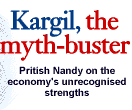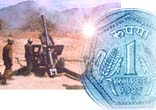

|
|
|
|
| HOME | BUSINESS | COMMENTARY | DEVIL'S ADVOCATE / PRITISH NANDY | |||
| July 20, 1999 |
  The Indian economy has been doing rather well for a while. But no one was quite prepared to believe this because it went against some of our most fundamental assumptions. Assumptions that I would like to believe are no more valid for our economy. In fact, they were never actually valid but just because they looked so convincing everyone took them to be true. Let us take Assumption One. That an economy can never do well unless there is absolute political stability. Nonsense. The Indian economy has been doing well only after political stability as we know it vanished from the scene. During the most stable years of Indian politics, under Nehru, Shastri and Indira Gandhi, the economy barely grew and all we did was sell bullshit dreams to our people. Abolition of privy purses; bank nationalisation; garibi hatao: most of our politics was plain sloganeering in those days. It is only after a tottering Narasimha Rao came to power in 1991 and appointed a politically feeble Manmohan Singh as his finance minister that the economy actually found itself on the growth track. It stayed on the growth track all through the unstable Rao years, when scam after scam hit the headlines and MPs were bribed to keep the government from collapsing.
Nor have any of the governments been particularly stable. Atal Bihari Vajpayee came and went in 13 days. Deve Gowda came and went in a few months. So did Inder Kumar Gujral. Vajpayee returned but barely for a year. Till a desperate Sonia did to him what Sitaram Kesri did to Deve Gowda. But all this rough and tumble of politics and the dark intrigues in the corridors of power did not weaken our economy in the least. In fact, it did just the opposite. The juggernaut of liberalisation rolled on (sometimes fast, sometimes slow) and, finally, in the most unstable of times (with a caretaker regime in office and a fractious war on our borders), our economy finally appears to have reached peak health! This is not a freak case. When trouble started on our borders, the Sensex began inching up towards 4,000. Instead of crumbling, as we are told economies usually do in times of war and strife, our fundamentals firmed up and during the worst months of the crisis, the Sensex stayed rock solid. As news of strategic victories kept pouring in, it improved and now when the war is almost over (at least for the time being), it is all set to cross the psychological barrier of 5,000. Twenty sectoral indices have already rushed past their old highs. Nifty and S&P CNX 500 have also scaled new peaks since the Pakistani troops crossed the LoC. Threats from Islamabad to replicate more Kargils in future have not had any impact. Nor the sightings of Osama Bin Laden near the Afghan frontier. Even the possibility of yet another unstable government being voted into power at the Centre has not made the slightest dent in the confidence level of the stock market. The level of 4,643 reached in September 1994 at the height of Harshad Mehta's bull run has been breached and it is unlikely that the Sensex will ever go below 4000 again, whatever the provocations. So much for political stability. Now let us take Assumption Two. That an economy can never do well in times of war or strife. Nonsense again. It was during a war, in fact the cruellest war that independent India has seen, with the highest casualty rate, that the economy has outperformed itself. Mind you, this was no second-hand war that people read about or heard of from the radio. This was the first war we saw on satellite television, where reports were filed from the bunkers, where camera crew went in with the assault troops. The huge cost of the war, the pain, the anguish, the grief and the enormous loss of human life and expensive military equipment was there for everyone to see, larger than life. Yet the stock market soared; the rupee stayed firm; foreign investors did not panic; in fact more money came in; the inflation index dropped to an amazing all-time low of 1.83 per cent! This defies our every assumption about the Indian economy. It also shows how mature we are as a nation; how strong our fundamentals are. The war on the borders, instead of frightening off investors and bringing the economy to its knees, did exactly the opposite. It helped to consolidate the nation and brought every feuding issue to a standstill. Caste wars in Bihar; communal tensions in UP; land and water disputes in Karnataka and Tamil Nadu; Naxalite violence in Andhra Pradesh; ULFA attacks in Assam: everything stopped when Pakistan attacked us. India became one. One nation. One people. With one objective: To stand strong and beat back the enemy. In diplomacy, we won every round. Even the Chinese did not back Pakistan, and Japan, after an initial error of judgement, quickly corrected its position. The Americans were with us all the way. So were the G-8 nations. But nothing reflected international opinion better than the fact that the Indian rupee stood its ground throughout the crisis and refused to give an inch. If you take the whole of last year, when there was virtually no stability whatsoever in political terms, the rupee lost just 1.87 per cent against the US dollar while currencies like the Russian rouble crumbled by as much as 308.33 per cent. What is even more amazing is that inflation, after 17 years, has now gone below two per cent (as per yesterday's figures) and Yashwant Sinha is confident that the GDP will record a seven per cent growth this year. With the current buoyancy in revenue earnings, Sinha may even drop the idea of a special Kargil tax to cover the cost of the war. In fact, the way we are going, we may be hurtling towards a zero inflation winter this year. No wonder, in June, while we were fighting the war, AT Kearney in its FDI Confidence Index listed India among the top six FDI destinations in the world, cheek by jowl with the US, theUK, China, Brazil and Mexico! What does this mean? Simple. That India is stronger than we think it is. Also, that we as a nation realise our true potential only in such moments of deep crisis. Kargil brought out the best in us and, even though we may not admit it, our finest talent lies in combating and conquering adversity, not just cruising along. That is why the Indian economy needs to be assessed differently. We are not Malaysia or Monte Carlo or the Maldives. We are not Russia or China or Vietnam either. We are this huge, complex, hardworking nation with a phenomenal memory of our past. We know how to work money and talent harder than most nations do. The FIIs appear to have figured this out. So has the world. It is now time we took advantage of this bull run to push for more liberalisation, more opening up of the Indian economy. This will further strengthen our fundamentals, give us greater confidence in ourselves and allow us to take on the world as equals. India has already proved that it is a global power today and it would be suicidal for us to now trim our ambitions and downsize our talent just to fit the image of an emerging nation. We are not an emerging nation any more. We are a part of the brave new world that will rule the next millennium. The quicker we recognise this and the faster we globalise, the easier it will be to realise our true destiny.
|
| Tell us what you think of this column | |
|
HOME |
NEWS |
BUSINESS |
SPORTS |
MOVIES |
CHAT |
INFOTECH |
TRAVEL
SHOPPING HOME | BOOK SHOP | MUSIC SHOP | HOTEL RESERVATIONS PERSONAL HOMEPAGES | FREE EMAIL | FEEDBACK |
|